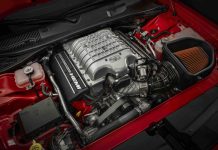Here’s the latest reader question, along with my reply!
Dave writes: Good for Ford (in re the new 7.3 liter V8; see here for more about that). About time. I thought all reason and sense had totally left the building. My preferences were always for Chevy trucks and Ford cars. Just from my personal experience. But I go way way way back. To simpler times. Innocently, last year I bought for my boy a vehicle I could not afford for myself. Bought him a 2002 Ford Explorer. Before long, you always learn something new, eh? Yep. A spark plug blew its way out of its cozy home place. Towing and repair cost me $700. I began to learn about engines built of plastic crap, aluminum crap, overhead cam crap, individual coil crap.
But, I wonder. Does Ford know something about little secrets in the “church” that we don’t? How, otherwise, would this new engine be allowed in the “free-est of all lands.” Or will the Car Pope’s lawyers soon find more lucre at hand? Thanks for all you do for us!
My reply: Plastic and aluminum have replaced cast iron chiefly for two reasons: To save weight and to make it easier/cheaper to manufacturer complex parts (e.g., intake manifolds). The upside is less weight – which is good for both fuel economy and performance. The downside is fragility relative to cast iron; plastic is brittle and easier to crack while aluminum is more vulnerable to being damaged by high heat (e.g., cylinder head warpage) or overtorquing of a fastener, etc. Threads are also more fragile – as you’ve discovered.
Cast iron is much harder to damage and parts like cylinder heads, intakes and blocks can easily last a human lifetime or even longer. I’ve got several ’70s-era cast iron Pontiac V8 intakes in the garage and – after cleaning them up and repainting them – they’d be literally as good as new. They can be used over and over again, almost indefinitely.
But they are heavy. About 25 pounds for an intake vs. almost nothing for a modern intake. And cylinder heads? One of my Pontiacs’s heads weighs at least 50 pounds; so 100-plus pounds for the pair. The fully dressed engine is close to 500 pounds, IIRC.
Contrast that with the Chevy LS V8 I hauled back from the machine shop recently. My buddy Tim and I picked it up and carried it – by hand – from the bed of his truck into the shop.
Chief Plenty Horses – the 455 in my Pontiac – isn’t going anywhere without a hoist and a dolly!
In re Ford and the new V8: Several factors at play here.
First, their OHC V8s – while they have gotten much better over the years – are more complex/expensive than GM and Ram’s OHV/pushrod V8s. The GM and Ram V8s also make tremendous power and that is especially important in the truck market. The 7.3 is a kind of acknowledgment that a mistake was made when Ford’s OHV V8s were dropped in favor of the “modular” 4.6/5.4 V8s and derivatives.
Second, this engine will de facto sub for the diesel in the 2500s… which has become too expensive due to emissions regs and no longer offers much advantage in terms of other things important to truck buyers such as lower operating costs.
I am praying Ford decides to do something heretical – and puts this engine in other vehicles, besides the 2500 and up series trucks!
. . .
Got a question about cars – or anything else? Click on the “ask Eric” link and send ’em in!
If you like what you’ve found here please consider supporting EPautos.
We depend on you to keep the wheels turning!
Our donate button is here.
If you prefer not to use PayPal, our mailing address is:
EPautos
721 Hummingbird Lane SE
Copper Hill, VA 24079
PS: Get an EPautos magnet (pictured below) in return for a $20 or more one-time donation or a $5 or more monthly recurring donation. (Please be sure to tell us you want a sticker – and also, provide an address, so we know where to mail the thing!)
My latest eBook is also available for your favorite price – free! Click here. 












Ford has rediscovered COMMON SENSE.
An OHV V8, equipped with modern computer-controlled fuel injection and engine management systems, ought to deliver horsepower, and, more important for a large truck, TORQUE comparable to a similar displacement engine with overhead cams, 4 valves per cylinder, and other exotic measures like the variable valve timing used in the four-banger on my Focus, in the RPM ranges that the vehicle will actually employ! In an application where durability and torque output are more important than high-end power and/or fuel economy, the “KISS” rule (Keep It Simple, Stupid) ought to apply.
Chevy Silverado has a 6.2L OHV engine yes? In both 2500 and super-high end 1500 lines? The Ram 5.7L is an OHV? What about the 4.7L?